Costing Systems, Budgeting, Overhead Allocation Analysis Report
VerifiedAdded on 2020/02/19
|6
|1405
|43
Homework Assignment
AI Summary
This assignment provides a comprehensive analysis of costing systems, emphasizing the importance of flexible budgeting over static budgeting and its application in variance identification. It explores cash budgeting, detailing the impact of sales, purchases, and administrative expenses on cash flow. The assignment also covers the operating cycle, its relation to working capital management, and the significance of a shorter operating cycle. It refutes the notion that government organizations do not need accounting, highlighting the need for financial transparency and decision-making. The core of the assignment focuses on costing systems, their purposes, and their role in cost control, inventory valuation, and profitability analysis. It includes a calculation of overhead and administrative allocation rates for a product, contrasting traditional and activity-based costing methods, and explaining the use of predetermined overhead rates.
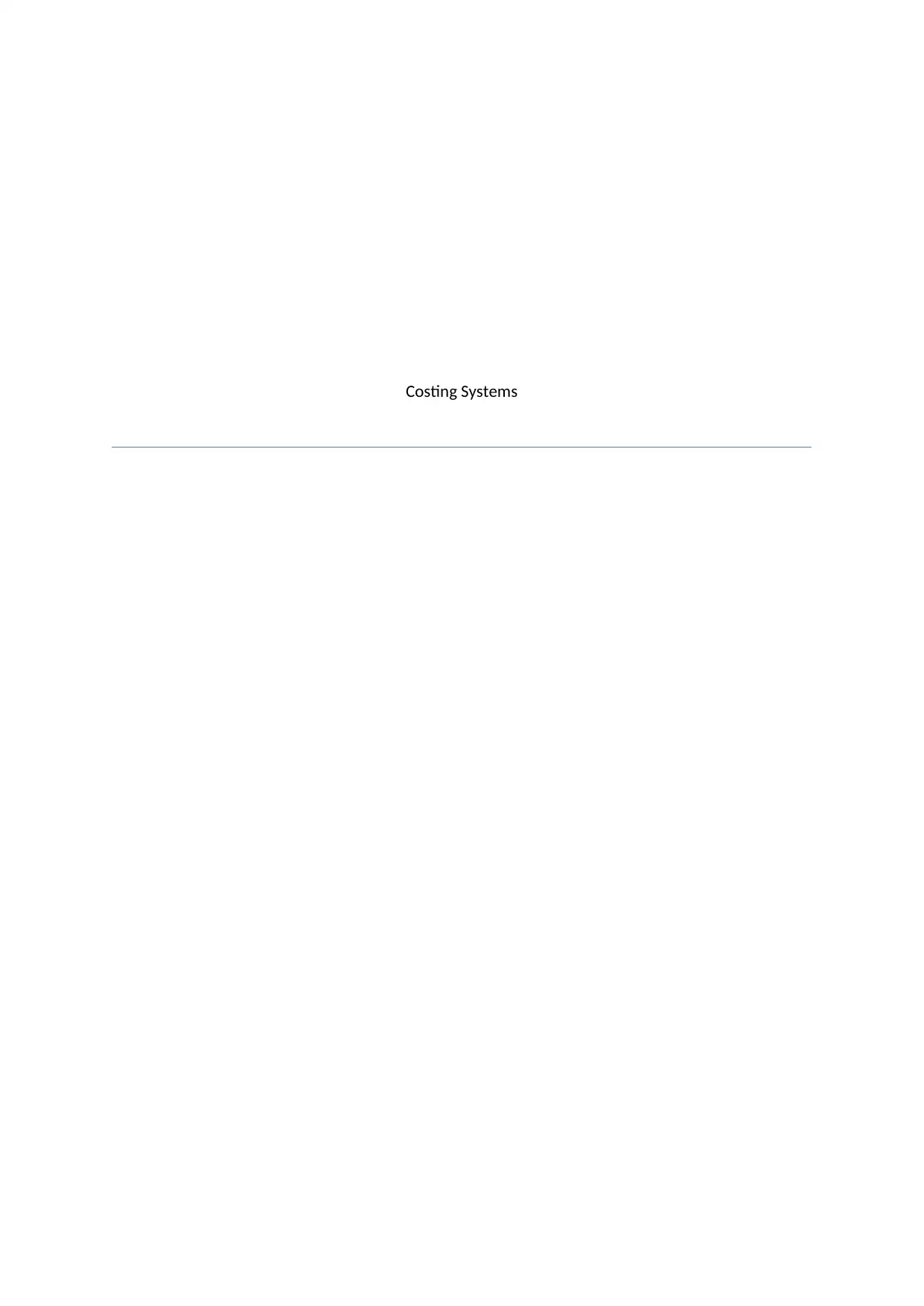
Costing Systems
Paraphrase This Document
Need a fresh take? Get an instant paraphrase of this document with our AI Paraphraser
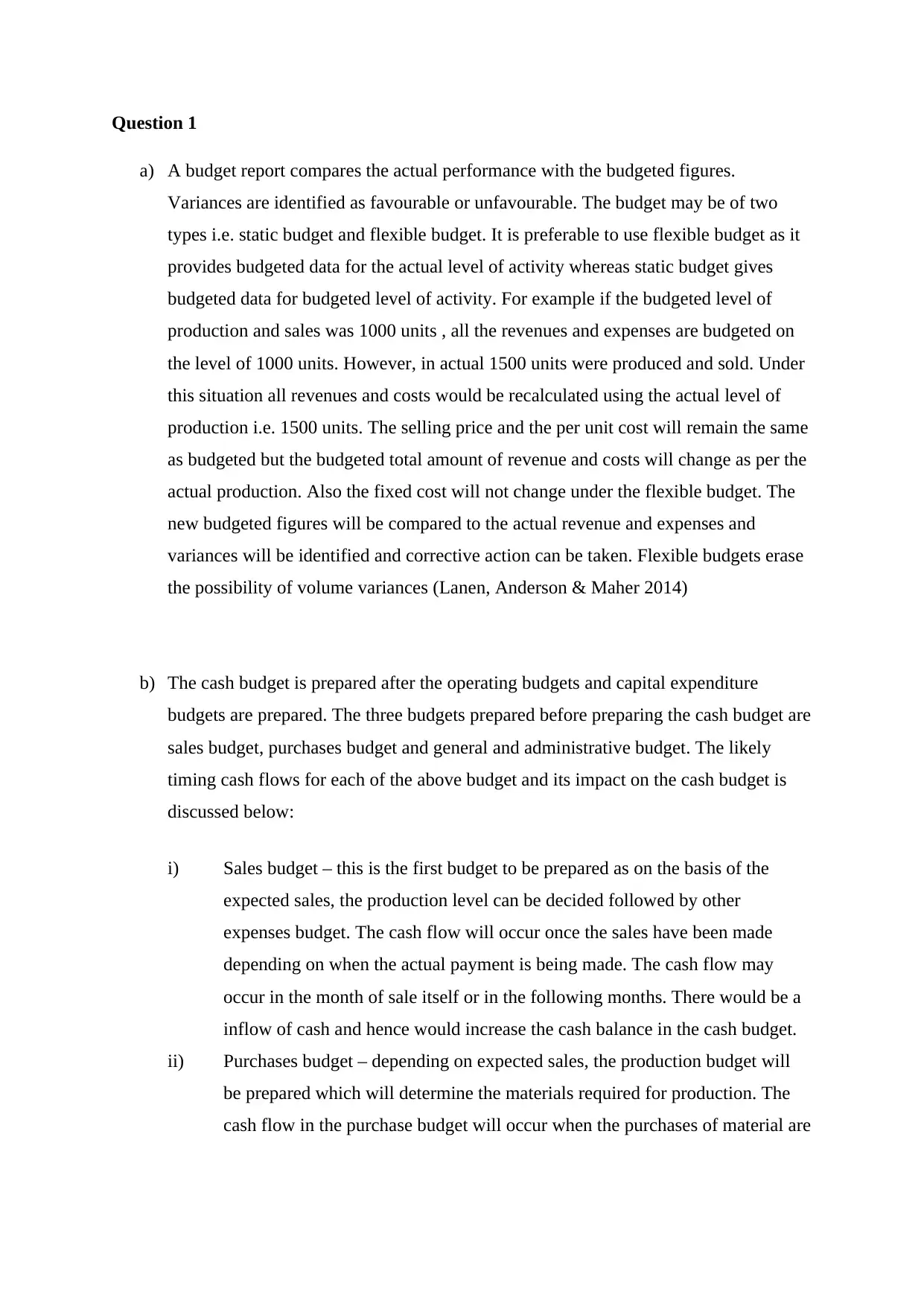
Question 1
a) A budget report compares the actual performance with the budgeted figures.
Variances are identified as favourable or unfavourable. The budget may be of two
types i.e. static budget and flexible budget. It is preferable to use flexible budget as it
provides budgeted data for the actual level of activity whereas static budget gives
budgeted data for budgeted level of activity. For example if the budgeted level of
production and sales was 1000 units , all the revenues and expenses are budgeted on
the level of 1000 units. However, in actual 1500 units were produced and sold. Under
this situation all revenues and costs would be recalculated using the actual level of
production i.e. 1500 units. The selling price and the per unit cost will remain the same
as budgeted but the budgeted total amount of revenue and costs will change as per the
actual production. Also the fixed cost will not change under the flexible budget. The
new budgeted figures will be compared to the actual revenue and expenses and
variances will be identified and corrective action can be taken. Flexible budgets erase
the possibility of volume variances (Lanen, Anderson & Maher 2014)
b) The cash budget is prepared after the operating budgets and capital expenditure
budgets are prepared. The three budgets prepared before preparing the cash budget are
sales budget, purchases budget and general and administrative budget. The likely
timing cash flows for each of the above budget and its impact on the cash budget is
discussed below:
i) Sales budget – this is the first budget to be prepared as on the basis of the
expected sales, the production level can be decided followed by other
expenses budget. The cash flow will occur once the sales have been made
depending on when the actual payment is being made. The cash flow may
occur in the month of sale itself or in the following months. There would be a
inflow of cash and hence would increase the cash balance in the cash budget.
ii) Purchases budget – depending on expected sales, the production budget will
be prepared which will determine the materials required for production. The
cash flow in the purchase budget will occur when the purchases of material are
a) A budget report compares the actual performance with the budgeted figures.
Variances are identified as favourable or unfavourable. The budget may be of two
types i.e. static budget and flexible budget. It is preferable to use flexible budget as it
provides budgeted data for the actual level of activity whereas static budget gives
budgeted data for budgeted level of activity. For example if the budgeted level of
production and sales was 1000 units , all the revenues and expenses are budgeted on
the level of 1000 units. However, in actual 1500 units were produced and sold. Under
this situation all revenues and costs would be recalculated using the actual level of
production i.e. 1500 units. The selling price and the per unit cost will remain the same
as budgeted but the budgeted total amount of revenue and costs will change as per the
actual production. Also the fixed cost will not change under the flexible budget. The
new budgeted figures will be compared to the actual revenue and expenses and
variances will be identified and corrective action can be taken. Flexible budgets erase
the possibility of volume variances (Lanen, Anderson & Maher 2014)
b) The cash budget is prepared after the operating budgets and capital expenditure
budgets are prepared. The three budgets prepared before preparing the cash budget are
sales budget, purchases budget and general and administrative budget. The likely
timing cash flows for each of the above budget and its impact on the cash budget is
discussed below:
i) Sales budget – this is the first budget to be prepared as on the basis of the
expected sales, the production level can be decided followed by other
expenses budget. The cash flow will occur once the sales have been made
depending on when the actual payment is being made. The cash flow may
occur in the month of sale itself or in the following months. There would be a
inflow of cash and hence would increase the cash balance in the cash budget.
ii) Purchases budget – depending on expected sales, the production budget will
be prepared which will determine the materials required for production. The
cash flow in the purchase budget will occur when the purchases of material are
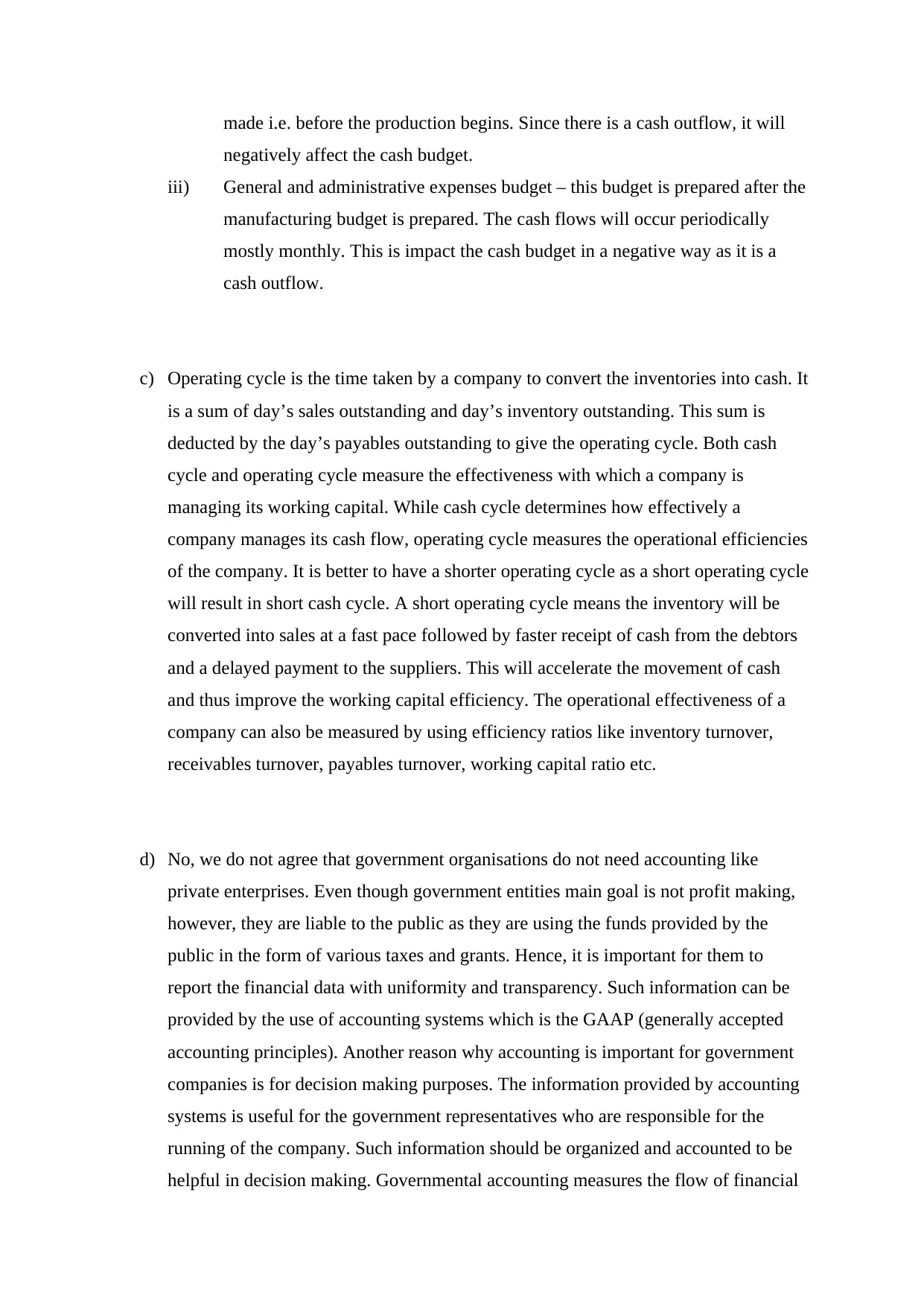
made i.e. before the production begins. Since there is a cash outflow, it will
negatively affect the cash budget.
iii) General and administrative expenses budget – this budget is prepared after the
manufacturing budget is prepared. The cash flows will occur periodically
mostly monthly. This is impact the cash budget in a negative way as it is a
cash outflow.
c) Operating cycle is the time taken by a company to convert the inventories into cash. It
is a sum of day’s sales outstanding and day’s inventory outstanding. This sum is
deducted by the day’s payables outstanding to give the operating cycle. Both cash
cycle and operating cycle measure the effectiveness with which a company is
managing its working capital. While cash cycle determines how effectively a
company manages its cash flow, operating cycle measures the operational efficiencies
of the company. It is better to have a shorter operating cycle as a short operating cycle
will result in short cash cycle. A short operating cycle means the inventory will be
converted into sales at a fast pace followed by faster receipt of cash from the debtors
and a delayed payment to the suppliers. This will accelerate the movement of cash
and thus improve the working capital efficiency. The operational effectiveness of a
company can also be measured by using efficiency ratios like inventory turnover,
receivables turnover, payables turnover, working capital ratio etc.
d) No, we do not agree that government organisations do not need accounting like
private enterprises. Even though government entities main goal is not profit making,
however, they are liable to the public as they are using the funds provided by the
public in the form of various taxes and grants. Hence, it is important for them to
report the financial data with uniformity and transparency. Such information can be
provided by the use of accounting systems which is the GAAP (generally accepted
accounting principles). Another reason why accounting is important for government
companies is for decision making purposes. The information provided by accounting
systems is useful for the government representatives who are responsible for the
running of the company. Such information should be organized and accounted to be
helpful in decision making. Governmental accounting measures the flow of financial
negatively affect the cash budget.
iii) General and administrative expenses budget – this budget is prepared after the
manufacturing budget is prepared. The cash flows will occur periodically
mostly monthly. This is impact the cash budget in a negative way as it is a
cash outflow.
c) Operating cycle is the time taken by a company to convert the inventories into cash. It
is a sum of day’s sales outstanding and day’s inventory outstanding. This sum is
deducted by the day’s payables outstanding to give the operating cycle. Both cash
cycle and operating cycle measure the effectiveness with which a company is
managing its working capital. While cash cycle determines how effectively a
company manages its cash flow, operating cycle measures the operational efficiencies
of the company. It is better to have a shorter operating cycle as a short operating cycle
will result in short cash cycle. A short operating cycle means the inventory will be
converted into sales at a fast pace followed by faster receipt of cash from the debtors
and a delayed payment to the suppliers. This will accelerate the movement of cash
and thus improve the working capital efficiency. The operational effectiveness of a
company can also be measured by using efficiency ratios like inventory turnover,
receivables turnover, payables turnover, working capital ratio etc.
d) No, we do not agree that government organisations do not need accounting like
private enterprises. Even though government entities main goal is not profit making,
however, they are liable to the public as they are using the funds provided by the
public in the form of various taxes and grants. Hence, it is important for them to
report the financial data with uniformity and transparency. Such information can be
provided by the use of accounting systems which is the GAAP (generally accepted
accounting principles). Another reason why accounting is important for government
companies is for decision making purposes. The information provided by accounting
systems is useful for the government representatives who are responsible for the
running of the company. Such information should be organized and accounted to be
helpful in decision making. Governmental accounting measures the flow of financial
⊘ This is a preview!⊘
Do you want full access?
Subscribe today to unlock all pages.

Trusted by 1+ million students worldwide
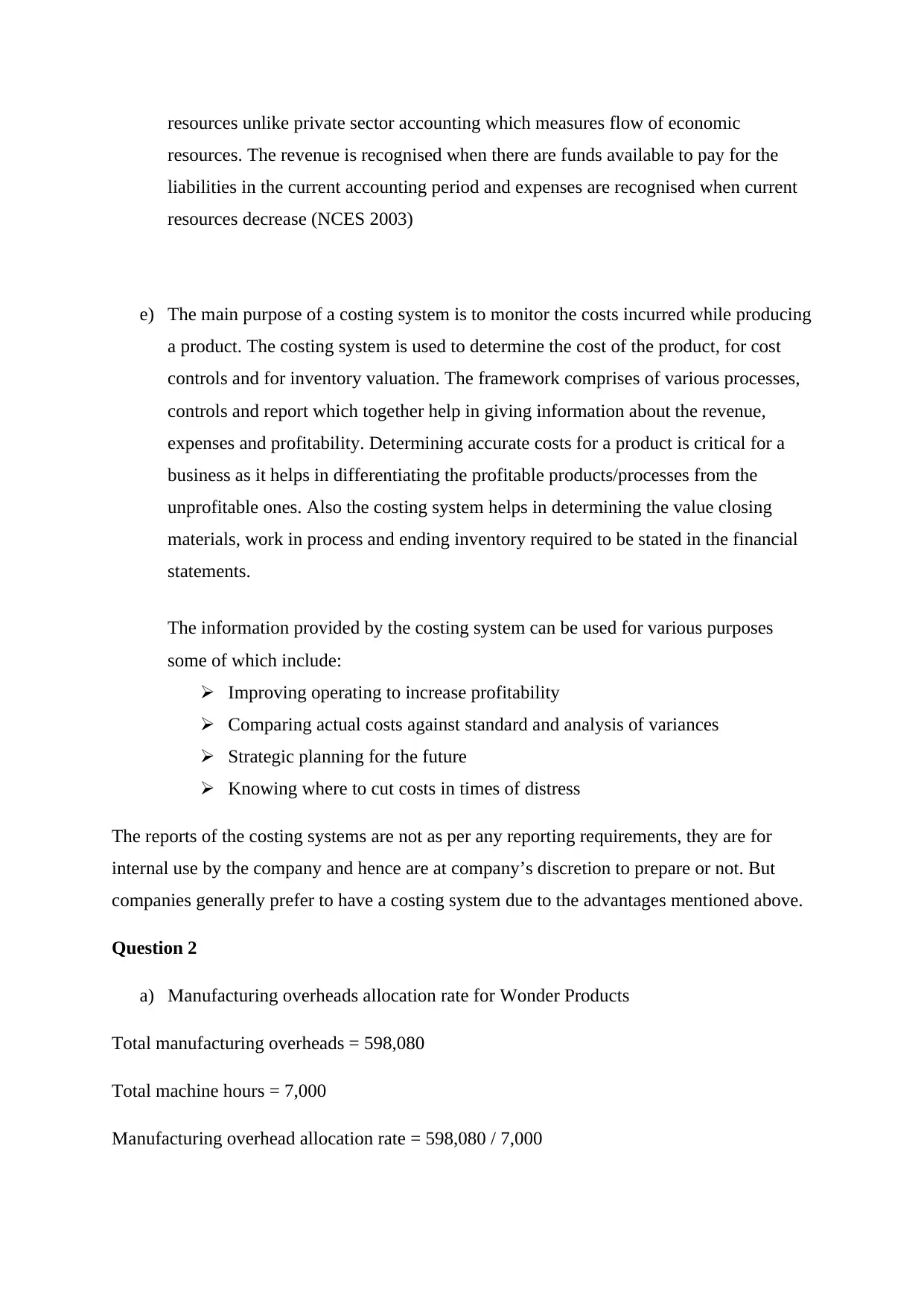
resources unlike private sector accounting which measures flow of economic
resources. The revenue is recognised when there are funds available to pay for the
liabilities in the current accounting period and expenses are recognised when current
resources decrease (NCES 2003)
e) The main purpose of a costing system is to monitor the costs incurred while producing
a product. The costing system is used to determine the cost of the product, for cost
controls and for inventory valuation. The framework comprises of various processes,
controls and report which together help in giving information about the revenue,
expenses and profitability. Determining accurate costs for a product is critical for a
business as it helps in differentiating the profitable products/processes from the
unprofitable ones. Also the costing system helps in determining the value closing
materials, work in process and ending inventory required to be stated in the financial
statements.
The information provided by the costing system can be used for various purposes
some of which include:
Improving operating to increase profitability
Comparing actual costs against standard and analysis of variances
Strategic planning for the future
Knowing where to cut costs in times of distress
The reports of the costing systems are not as per any reporting requirements, they are for
internal use by the company and hence are at company’s discretion to prepare or not. But
companies generally prefer to have a costing system due to the advantages mentioned above.
Question 2
a) Manufacturing overheads allocation rate for Wonder Products
Total manufacturing overheads = 598,080
Total machine hours = 7,000
Manufacturing overhead allocation rate = 598,080 / 7,000
resources. The revenue is recognised when there are funds available to pay for the
liabilities in the current accounting period and expenses are recognised when current
resources decrease (NCES 2003)
e) The main purpose of a costing system is to monitor the costs incurred while producing
a product. The costing system is used to determine the cost of the product, for cost
controls and for inventory valuation. The framework comprises of various processes,
controls and report which together help in giving information about the revenue,
expenses and profitability. Determining accurate costs for a product is critical for a
business as it helps in differentiating the profitable products/processes from the
unprofitable ones. Also the costing system helps in determining the value closing
materials, work in process and ending inventory required to be stated in the financial
statements.
The information provided by the costing system can be used for various purposes
some of which include:
Improving operating to increase profitability
Comparing actual costs against standard and analysis of variances
Strategic planning for the future
Knowing where to cut costs in times of distress
The reports of the costing systems are not as per any reporting requirements, they are for
internal use by the company and hence are at company’s discretion to prepare or not. But
companies generally prefer to have a costing system due to the advantages mentioned above.
Question 2
a) Manufacturing overheads allocation rate for Wonder Products
Total manufacturing overheads = 598,080
Total machine hours = 7,000
Manufacturing overhead allocation rate = 598,080 / 7,000
Paraphrase This Document
Need a fresh take? Get an instant paraphrase of this document with our AI Paraphraser
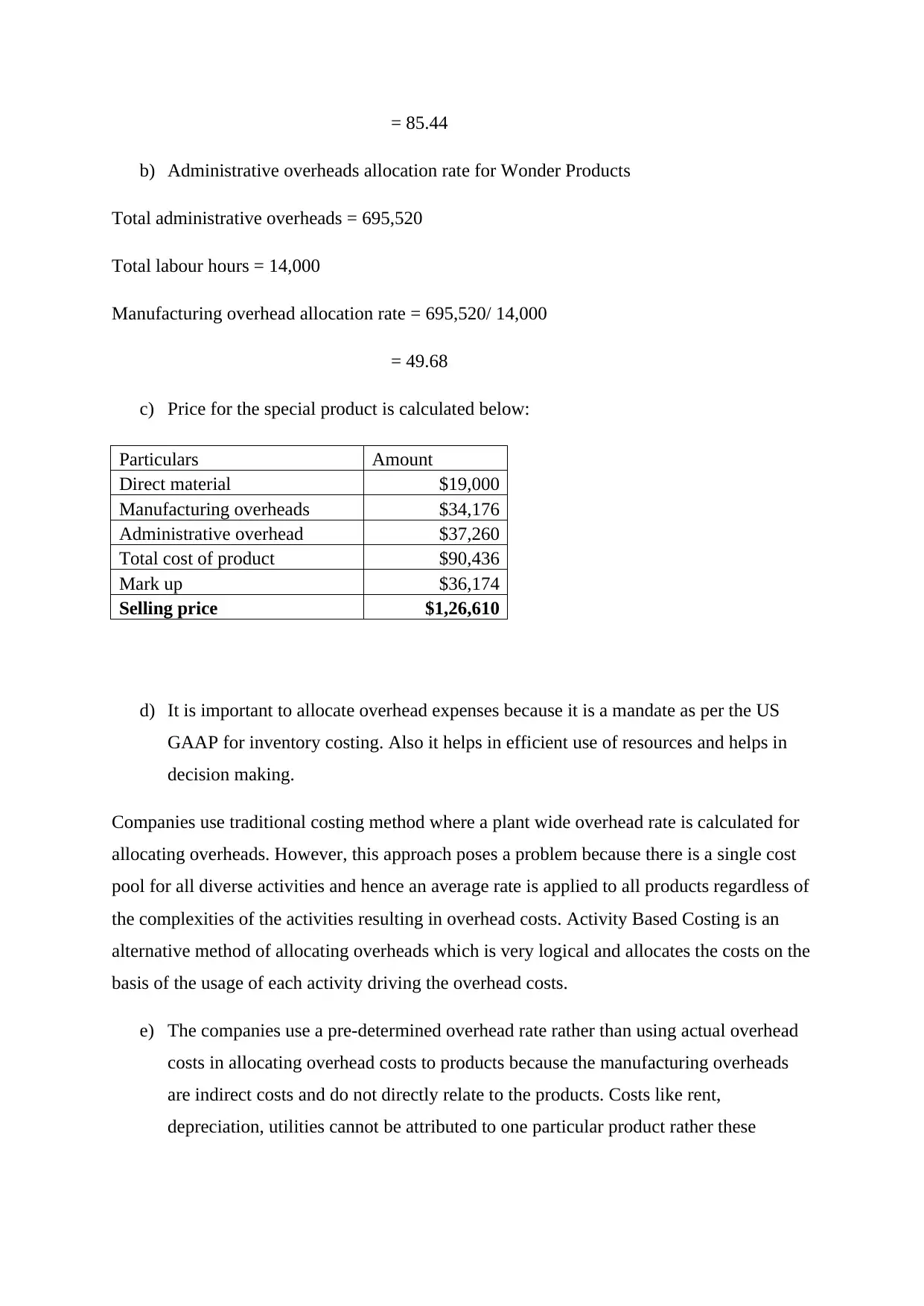
= 85.44
b) Administrative overheads allocation rate for Wonder Products
Total administrative overheads = 695,520
Total labour hours = 14,000
Manufacturing overhead allocation rate = 695,520/ 14,000
= 49.68
c) Price for the special product is calculated below:
Particulars Amount
Direct material $19,000
Manufacturing overheads $34,176
Administrative overhead $37,260
Total cost of product $90,436
Mark up $36,174
Selling price $1,26,610
d) It is important to allocate overhead expenses because it is a mandate as per the US
GAAP for inventory costing. Also it helps in efficient use of resources and helps in
decision making.
Companies use traditional costing method where a plant wide overhead rate is calculated for
allocating overheads. However, this approach poses a problem because there is a single cost
pool for all diverse activities and hence an average rate is applied to all products regardless of
the complexities of the activities resulting in overhead costs. Activity Based Costing is an
alternative method of allocating overheads which is very logical and allocates the costs on the
basis of the usage of each activity driving the overhead costs.
e) The companies use a pre-determined overhead rate rather than using actual overhead
costs in allocating overhead costs to products because the manufacturing overheads
are indirect costs and do not directly relate to the products. Costs like rent,
depreciation, utilities cannot be attributed to one particular product rather these
b) Administrative overheads allocation rate for Wonder Products
Total administrative overheads = 695,520
Total labour hours = 14,000
Manufacturing overhead allocation rate = 695,520/ 14,000
= 49.68
c) Price for the special product is calculated below:
Particulars Amount
Direct material $19,000
Manufacturing overheads $34,176
Administrative overhead $37,260
Total cost of product $90,436
Mark up $36,174
Selling price $1,26,610
d) It is important to allocate overhead expenses because it is a mandate as per the US
GAAP for inventory costing. Also it helps in efficient use of resources and helps in
decision making.
Companies use traditional costing method where a plant wide overhead rate is calculated for
allocating overheads. However, this approach poses a problem because there is a single cost
pool for all diverse activities and hence an average rate is applied to all products regardless of
the complexities of the activities resulting in overhead costs. Activity Based Costing is an
alternative method of allocating overheads which is very logical and allocates the costs on the
basis of the usage of each activity driving the overhead costs.
e) The companies use a pre-determined overhead rate rather than using actual overhead
costs in allocating overhead costs to products because the manufacturing overheads
are indirect costs and do not directly relate to the products. Costs like rent,
depreciation, utilities cannot be attributed to one particular product rather these
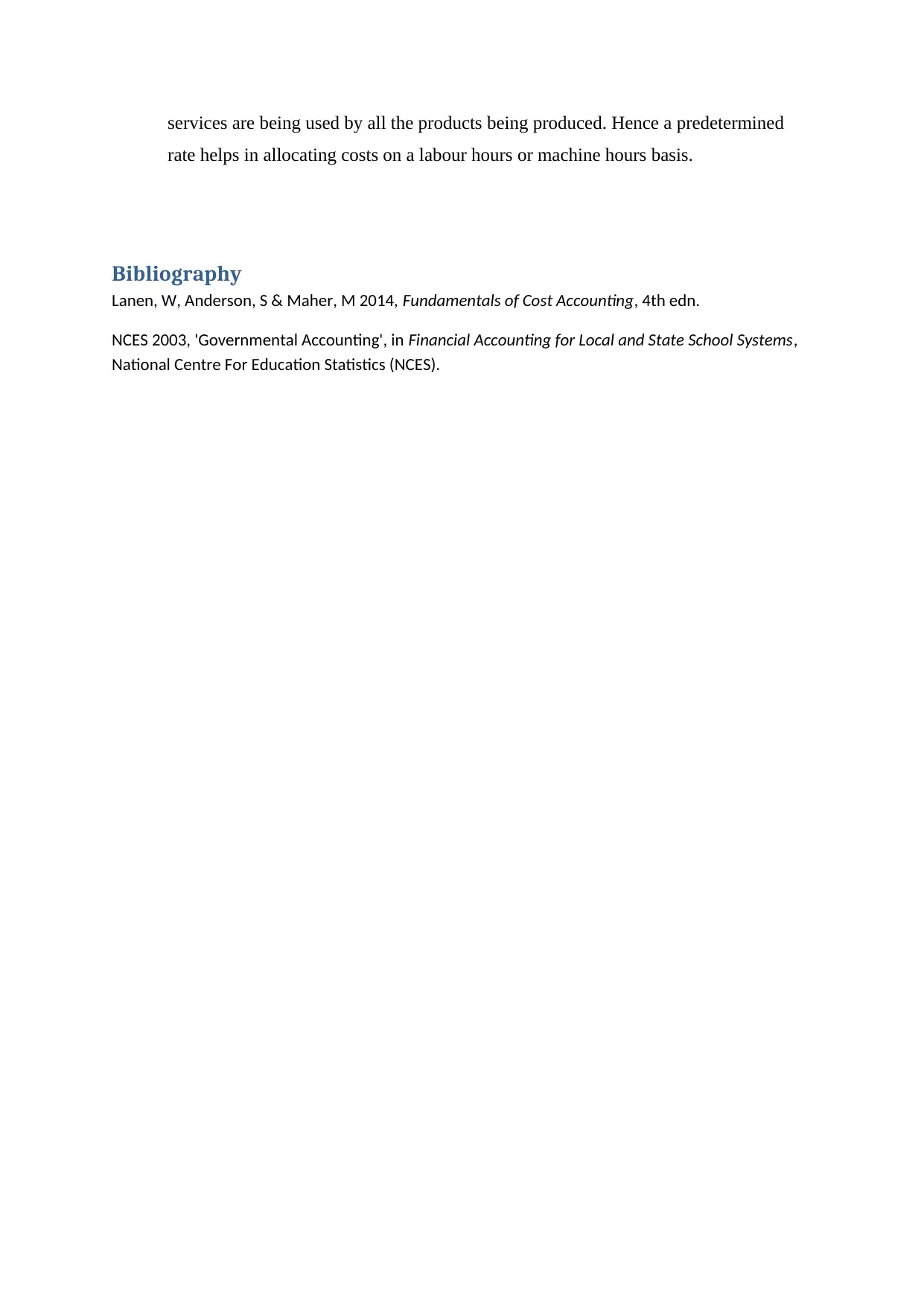
services are being used by all the products being produced. Hence a predetermined
rate helps in allocating costs on a labour hours or machine hours basis.
Bibliography
Lanen, W, Anderson, S & Maher, M 2014, Fundamentals of Cost Accounting, 4th edn.
NCES 2003, 'Governmental Accounting', in Financial Accounting for Local and State School Systems,
National Centre For Education Statistics (NCES).
rate helps in allocating costs on a labour hours or machine hours basis.
Bibliography
Lanen, W, Anderson, S & Maher, M 2014, Fundamentals of Cost Accounting, 4th edn.
NCES 2003, 'Governmental Accounting', in Financial Accounting for Local and State School Systems,
National Centre For Education Statistics (NCES).
⊘ This is a preview!⊘
Do you want full access?
Subscribe today to unlock all pages.

Trusted by 1+ million students worldwide
1 out of 6
Related Documents
Your All-in-One AI-Powered Toolkit for Academic Success.
+13062052269
info@desklib.com
Available 24*7 on WhatsApp / Email
![[object Object]](/_next/static/media/star-bottom.7253800d.svg)
Unlock your academic potential
Copyright © 2020–2025 A2Z Services. All Rights Reserved. Developed and managed by ZUCOL.





